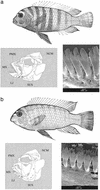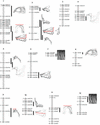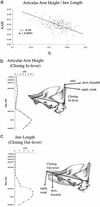Directional selection has shaped the oral jaws of Lake Malawi cichlid fishes
- PMID: 12704237
- PMCID: PMC154331
- DOI: 10.1073/pnas.0930235100
Directional selection has shaped the oral jaws of Lake Malawi cichlid fishes
Abstract
East African cichlid fishes represent one of the most striking examples of rapid and convergent evolutionary radiation among vertebrates. Models of ecological speciation would suggest that functional divergence in feeding morphology has contributed to the origin and maintenance of cichlid species diversity. However, definitive evidence for the action of natural selection has been missing. Here we use quantitative genetics to identify regions of the cichlid genome responsible for functionally important shape differences in the oral jaw apparatus. The consistent direction of effects for individual quantitative trait loci suggest that cichlid jaws and teeth evolved in response to strong, divergent selection. Moreover, several chromosomal regions contain a disproportionate number of quantitative trait loci, indicating a prominent role for pleiotropy or genetic linkage in the divergence of this character complex. Of particular interest are genomic intervals with concerted effects on both the length and height of the lower jaw. Coordinated changes in this area of the oral jaw apparatus are predicted to have direct consequences for the speed and strength of jaw movement. Taken together, our results imply that the rapid and replicative nature of cichlid trophic evolution is the result of directional selection on chromosomal packages that encode functionally linked aspects of the craniofacial skeleton.
Figures




Similar articles
-
The Integrated Genomic Architecture and Evolution of Dental Divergence in East African Cichlid Fishes (Haplochromis chilotes x H. nyererei).G3 (Bethesda). 2017 Sep 7;7(9):3195-3202. doi: 10.1534/g3.117.300083. G3 (Bethesda). 2017. PMID: 28751505 Free PMC article.
-
Bentho-pelagic divergence of cichlid feeding architecture was prodigious and consistent during multiple adaptive radiations within African rift-lakes.PLoS One. 2010 Mar 8;5(3):e9551. doi: 10.1371/journal.pone.0009551. PLoS One. 2010. PMID: 20221400 Free PMC article.
-
Sequence analyses of the distal-less homeobox gene family in East African cichlid fishes reveal signatures of positive selection.BMC Evol Biol. 2013 Jul 17;13:153. doi: 10.1186/1471-2148-13-153. BMC Evol Biol. 2013. PMID: 23865956 Free PMC article.
-
Genetic and developmental basis of cichlid trophic diversity.Heredity (Edinb). 2006 Sep;97(3):211-21. doi: 10.1038/sj.hdy.6800864. Epub 2006 Jul 12. Heredity (Edinb). 2006. PMID: 16835594 Review.
-
The interaction of sexually and naturally selected traits in the adaptive radiations of cichlid fishes.Mol Ecol. 2009 Jan;18(2):169-85. doi: 10.1111/j.1365-294X.2008.03981.x. Epub 2008 Nov 4. Mol Ecol. 2009. PMID: 18992003 Review.
Cited by
-
Genetic analyses in Lake Malawi cichlids identify new roles for Fgf signaling in scale shape variation.Commun Biol. 2018 May 31;1:55. doi: 10.1038/s42003-018-0060-4. eCollection 2018. Commun Biol. 2018. PMID: 30271938 Free PMC article.
-
High-resolution mutation mapping reveals parallel experimental evolution in yeast.PLoS Biol. 2006 Jul;4(8):e256. doi: 10.1371/journal.pbio.0040256. PLoS Biol. 2006. PMID: 16856782 Free PMC article.
-
Microevolutionary change in viscerocranial bones under congeneric sympatry in the Lake Tanganyikan cichlid genus Tropheus.Hydrobiologia. 2021;848(16):3639-3653. doi: 10.1007/s10750-021-04536-7. Epub 2021 Feb 22. Hydrobiologia. 2021. PMID: 34720168 Free PMC article.
-
Hybridization produces novelty when the mapping of form to function is many to one.BMC Evol Biol. 2008 Apr 28;8:122. doi: 10.1186/1471-2148-8-122. BMC Evol Biol. 2008. PMID: 18442407 Free PMC article.
-
Modularity of the oral jaws is linked to repeated changes in the craniofacial shape of african cichlids.Int J Evol Biol. 2011;2011:641501. doi: 10.4061/2011/641501. Epub 2011 Apr 12. Int J Evol Biol. 2011. PMID: 21716745 Free PMC article.
References
-
- Fryer G, Iles T D. The Cichlid Fishes of the Great Lakes of Africa: Their Biology and Evolution. Edinburgh: Oliver and Boyd; 1972.
-
- Meyer A, Kocher T D, Basasibwaki P, Wilson A C. Nature. 1990;347:550–553. - PubMed
-
- Danley P D, Kocher T D. Mol Ecol. 2001;10:1075–1086. - PubMed
-
- Liem K F. In: Cichlid Fishes: Behavior, Ecology and Evolution. Keenleyside M H A, editor. London: Chapman and Hall; 1991. pp. 129–150.
Publication types
MeSH terms
Substances
Associated data
- Actions
- Actions
- Actions
- Actions
- Actions
- Actions
- Actions
- Actions
- Actions
- Actions
- Actions
- Actions
- Actions
- Actions
- Actions
- Actions
- Actions
- Actions
- Actions
- Actions
- Actions
- Actions
- Actions
- Actions
- Actions
- Actions
- Actions
- Actions
- Actions
- Actions
- Actions
- Actions
- Actions
- Actions
- Actions
- Actions
- Actions
- Actions
- Actions
- Actions
- Actions
- Actions
- Actions
- Actions
- Actions
- Actions
- Actions
- Actions
- Actions
- Actions
- Actions
- Actions
- Actions
- Actions
- Actions
- Actions
- Actions
- Actions
- Actions
- Actions
- Actions
- Actions
- Actions
- Actions
- Actions
- Actions
- Actions
- Actions
- Actions
- Actions
- Actions
- Actions
- Actions
- Actions
- Actions
- Actions
- Actions
- Actions
- Actions
- Actions
- Actions
- Actions
- Actions
- Actions
Grants and funding
LinkOut - more resources
Full Text Sources

